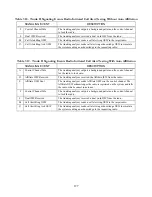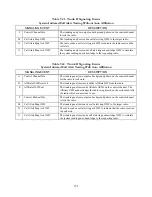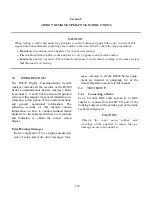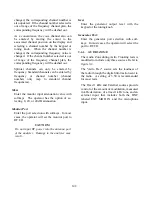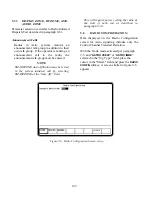
Trunk II or Astro signaling is selected. The
operator has the option of disabling the auto
affiliation sequence, or selecting the
SMARTZONE affiliation sequence. If the
radio is not capable of SMARTZONE auto
affiliation, the selection should be set to
DISABLED.
If auto affiliation is disabled, the analyzer
transmits idle data on the control channel until
the radio initiates the test sequence.
9-6.2
Testing the Auto Affiliation Feature
After setting up the test conditions with the radio
turned "off," press the
start test
softkey to
activate control channel signaling. Turn the radio
"on" when the prompt message appears so it can
lock to the control channel and register.
Successful registration will be indicated by
seeing the squelch indicator LED flash briefly
followed by the presence of decoded radio ID
parameters The call type M1 should be displayed
to indicate that an auto affiliation sequence has
been received. At this time, the radio may be
keyed to proceed with the radio initiated calling
sequence.
The radio will remain registered as long as it
remains powered up and there have been no
changes in basic test configuration. Stopping and
re-starting the test requires re-registration as long
as SMARTZONE is selected at the "Auto Aff:"
field on the screen.
NOTE
If changes to the test setup entries are made
after a test has been started, even though
theses changes appear on the screen, they will
not be entered as part of the test until the test
is ended and restarted. Similarly, if invalid
entries are made for frequency or other
parameters, they may be accepted until a final
validity check is done by the system at the time
the
"start test"
softkey is pressed.
9-6.3 RF
ZONE
Band:
Band selects the frequency channel plan for the
analyzer. For Astro trunked radio, the only
selection is 800 MHz (US). The 800 MHz (US)
band configures the analyzer for the frequency
and channel plan described in table 9-1. This
table shows analyzer transmit frequency
ranges.
CCTx:
CCTx is the control channel transmit frequency
of the analyzer. The control channel frequency
can be changed by moving the cursor into the
CCTx cursor field and changing the value with
the keypad or with the tuning knob. When the
control channel frequency is changed, the
corresponding channel number is also updated.
If the frequency selected is out of range of the
frequency channel plan, the corresponding
channel number will be dashed out.
As a convenience, the control channel can also
be entered by moving the cursor to the
associated channel position on the display and
selecting a channel number with the keypad or
tuning knob. When the channel number is
changed, the corresponding frequency value is
changed. If the channel number selected is out
of range of the frequency channel plan, the
corresponding frequency will be dashed out.
Splinter channels can only be entered by
frequency. Standard channels can be entered by
frequency or channel number (channel
numbers only map to standard channel
frequencies).
VCTx:
VCTx sets the voice channel transmit fre-
quency of the analyzer. The voice channel
frequency can be changed by moving the
cursor into the VCTx cursor field and changing
the value with the keypad or with the tuning
knob. When the voice channel frequency is
141
Summary of Contents for R2600 Series
Page 8: ...3 7 1 3 AC DC Voltmeter 41 3 7 1 4 INT DIST EXT DIST Meter 43 v...
Page 46: ...This Page Intentionally Left Blank xxxvi...
Page 66: ...DISPLAY ZONE RF ZONE AUDIO ZONE Figure 3 1 Screen Zone Arrangement 20...
Page 68: ...Figure 3 2 System Help 22...
Page 83: ...Figure 3 11 General Sequence Mode Select 37...
Page 85: ...39 Figure 3 12 RF Display Zone...
Page 88: ...Figure 3 14 Digital Voltmeter Screens 42...
Page 102: ...Figure 3 22 Bar Graphs 56...
Page 107: ...Figure 3 24 Memory Screens 61...
Page 128: ...This Page Intentionally Left Blank 82...
Page 202: ...This Page Intentionally Left Blank 156...
Page 205: ...Figure 11 1 R 2670 with SECURENET Option Housing 159...
Page 206: ...This Page Intentionally Left Blank 160...
Page 218: ...Figure 13 8 Test Key Programming Display Figure 13 9 External Key Programming Display 172...
Page 225: ...Figure 13 12 Duplex Mode Display Zone 179...
Page 234: ...VOICE Figure 13 17 CLEAR SCOPE Markers 188...
Page 236: ...This Page Intentionally Left Blank 190...
Page 249: ...Figure 14 8 SECURENET CLEAR SCOPE Display of Output Modulation 203...
Page 252: ...This Page Intentionally Left Blank 206...
Page 256: ...210 This Page Intentionally Left Blank...
Page 267: ...Figure 17 7 Encryption Select Display Figure 17 7 Encryption Select Display 221 221...
Page 286: ...This Page Intentionally Left Blank 240...
Page 291: ...Figure 18 1 Radio BER Test Mode Audio Zone Figure 18 2 Radio BER Test Mode BER Meter 245...
Page 293: ...Figure 18 4 Receive BER 247...
Page 298: ...Figure 18 6 ASTRO CLEAR SCOPE Display of Output Modulation 252...
Page 304: ...Figure 21 1 PROJ 25 Version Screen Figure 21 2 PROJ 25 Options Screen 258...
Page 309: ...Figure 21 6 SET UP Display Screen Figure 21 7 Encryption Select Display 263...
Page 335: ...Figure 22 4 PROJ 25 CONV CLEAR SCOPE Display of Output Modulation 289...
Page 339: ...Figure 24 1 PROJ 25 Version Screen Figure 24 2 PROJ 25 Options Screen 293...
Page 354: ...Figure 25 3 Encryption Select Display Figure 25 4 Algorithm Select Display 308...
Page 369: ...B 6 This Page Intentionally Left Blank...
Page 379: ...This Page Intentionally Left Blank F 4...
Page 383: ...This Page Intentionally Left Blank H 2...
Page 389: ...J 4 This Page Intentionally Left Blank...
Page 393: ...This Page Intentionally Left Blank K 4...

